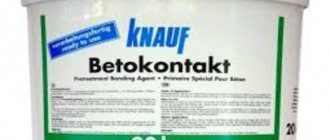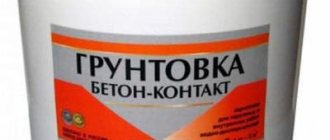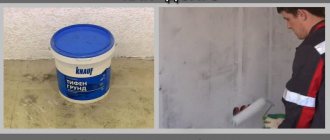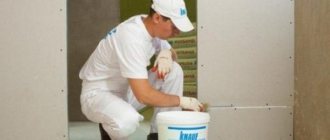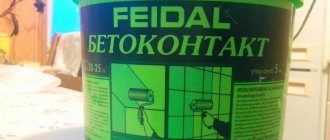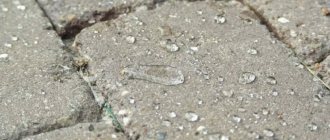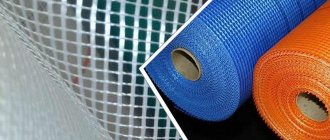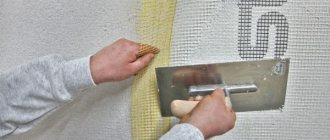To improve adhesion with substrates such as tiles, paint, monolithic concrete or a glossy surface that has insufficient adhesion and minimal moisture absorption, a water-dispersive primer “Concrete Contact” is used. It is characterized by a high level of resistance to alkali, turning a glossy surface into a rough one. This ensures the quality and reliability of the work performed. The “Concrete Contact” primer is based on quartz sand and polymers. Thanks to these components, adhesion increases several times.
general information
Let's find out why Concrete contact is needed. When it is necessary to roughen non-absorbent, dense, smooth substrates to improve adhesion (adhesion, stickiness), the Betonokontakt primer is successfully used. This makes it easier to subsequently lay plaster and gypsum putty. The material design varies, designed for different operating conditions and requirements for the basic rough surface.
The primer was invented by the German company FEIDAL. In the original it is called Betokontakt. In Russia, it is most often called Betonokontakt, since initially the ready-made mixture was always applied to concrete.
There are various other names for soil that are given by manufacturers to distinguish their product from competitors. The original composition remains with the company-inventor.
For others it may differ slightly.
Concrete contact has the following positive qualities:
- environmental friendliness;
- vapor permeability;
- high drying speed;
- long service life;
- durability.
Purpose
The features of the presented product allow it to be used both to improve adhesion and for a waterproofing effect. The properties of the “Concrete-Contact” primer are such that it is rational to use it only for smooth surfaces that do not absorb moisture. For a rough base, a regular deep penetration product will do. It will cost less and will be more rational for absorbent surfaces.
“Concrete Contact” is used for monolithic blocks, old tiles, and alkyd paint. After it, you can apply such types of coatings as gypsum, cement plasters and putties, as well as tile adhesive.
A primer is used indoors and outdoors, which allows for the installation of various finishing materials. A popular product is the Concrete Contact primer from Prospectors. It contains special additives that allow it to withstand atmospheric loads. They increase moisture and frost resistance. It also contains antiseptic components. Thanks to the use of this material, the finish can be used for many years.
Knauf is also a leader in this area. Their products are tested together, and they have proven themselves to be positive in the quality market.
Kinds
Betonokontakt primer is available in two types:
- Acrylic (polymer). Used for facade, street and interior work. Panels treated with this primer provide indoor comfort.
- Water-dispersed. Suitable for working with drywall, monolithic concrete slabs, processing wooden and plastic structures. And also for impregnating plaster before gluing vinyl and paper wallpaper. Well emphasizes the structure of masonry and wood.
The primer also differs in:
- size of grains of quartz sand;
- purpose (external, internal work, combined).
Use the primer strictly for its intended purpose!
When taking into account the manufacturer's recommendations, the efficiency of working with the mixture increases significantly, and the primer consumption itself decreases.
Compound
Any variation of Concrete Contact, regardless of the manufacturer, contains the following:
- Acrylic dispersion or copolymers. Responsible for adhesion - stickiness. Leaves a sticky viscous layer after drying. The quality of the polymers included in the composition affects the durability of the primer.
- Fillers. Mostly quartz sand, but there are others. They are used to create roughness, which improves adhesion when applying the next layer.
- Additives and additives that give Betonokontakt additional properties: water repellency, frost resistance, antibacterial properties.
- Dyes. To control the application process without bald spots. When such a component is not in the composition, you can add it yourself.
- The acidity level of Betonokontakt is neutral, which allows the primer to be used under both gypsum and cement putties and plasters.
Purpose and scope
Let's look at what concrete contact primer is used for. This is a primer for bases that do not absorb water, which are smooth and the plaster falls off when it dries, since it cannot cling to anything.
Impregnation with a special composition is required.
Concrete contact is the lifesaver that eliminates these problems by making the surface rough.
According to its intended purpose, the primer is available in 3 versions:
- For interior decoration of heated premises. At low temperatures they peel off and fall off along with the plaster.
- For external facade finishing. Withstands temperature range -40…+60°С. They are also suitable for interior work, as they are essentially universal.
- Frost-resistant, capable of withstanding up to 5 freeze-thaw cycles during storage without loss of quality. Manufacturers produce such a mixture for both internal and external facade work.
It is worth noting that Betonokontakt for external facade work is used for winter conservation of plaster when facing work is not completed.
Since the composition is not a cheap building material and is quite expensive, it must be used for its intended purpose, according to the manufacturer’s instructions. At the same time, the recommendations of sales consultants and manufacturers may not coincide!
What surfaces to apply to?
Thanks to abrasive grains of quartz sand or other crystalline filler, Betonokontakt forms a rough viscous layer on the surface. Additional support is created for applying a layer of plaster on a complex smooth base.
Unfortunately, not all surfaces are suitable for treatment with this primer. Only bases that do not absorb moisture! Of which there are not so many:
- Smooth non-porous concrete. Usually in panel multi-storey buildings. For loose and porous concrete, a different primer is needed.
- Wooden and metal fragments. Beams and projections. For complete plastering, other technologies are used.
The wood must be dry when applying the primer!
- Ceramic tile. When for one reason or another it is not possible to knock down the old tile, but you need to glue a new one. Concrete contact is used to increase adhesion. It is enough to walk twice over the surface to begin gluing a new tile on top of the old one without the risk of everything falling off.
Primer is not applied to other surfaces not listed!
It is worth noting that any finishing materials, including putty, will be applied to freshly applied plaster. It makes no sense to additionally treat the surface with Concrete Contact.
Required tools for application
The primer is applied in the following way:
- Hair brush with medium or hard bristles, mixed or synthetic. The most economical way to use Concrete Contact.
- Brush, short or medium. Long ones are difficult to clean. For processing difficult areas, cracks, bumps and depressions, surfaces with complex configurations.
- With a roller. Pile length 12-18 mm. For processing large areas. During application, difficulties arise with uniform distribution of the primer over the surface. The work is easier, but the consumption of the finished mixture increases significantly!
Varieties
Today you can find on sale a fairly large selection of concrete contacts from different manufacturers and for a variety of purposes. Each individual type has its own specific characteristics and properties, which should definitely be taken into account when purchasing a particular primer.
For wallpaper paint
In order to determine whether the paint is being removed from the surface of the walls, it is necessary to apply hot water to a small area several times and wait a while. If the paint can be removed with a spatula without any problems, then it would be better to remove it completely. If it still holds firmly, then the best option would be to use a concrete contact primer. It is worth considering some important points.
- For the ceiling, it is best to purchase concrete contact, which will have a minimum solid fraction. In the case of walls, it is worth considering how heavy the layer of plaster or paint will be applied in the future.
- Before you start treating the surface, it will need to be thoroughly cleaned of dust and dirt.
- The primer must be applied in at least two layers. Each one must be completely dry. Only after this can plaster or any other finishing coating be applied, but no later than 24 hours later.
For drywall
Despite the huge number of advantages, drywall has two very serious disadvantages. This material is very fragile and quickly absorbs huge amounts of moisture. If you prime drywall correctly, this will improve its characteristics several times and make it more durable, moisture-resistant and reliable. The ideal solution in this situation would be to use an acrylic primer, which includes concrete contact.
The material will be able to reliably hold all those substances and finishes that will then be applied over the primer.
In this situation, special attention should be paid to the joints between plasterboard slabs. They should be pre-treated with gypsum putty. If there are defects or scratches on the sheets of material, as well as for more economical use of concrete contact, you can additionally use a deep penetration acrylic primer.
On gypsum plaster
Gypsum plaster is considered a very popular material that is used for finishing work. With its help you can get an ideal surface. But due to the too high porosity, such plaster will strongly absorb moisture, which will lead to the appearance of numerous defects. Concrete contact will help eliminate this problem. It is advisable to first coat the surface with a deep penetration primer. Due to this, any other finishing materials will remain on the surface for a long time. The soil will also protect against mold or mildew and various types of defects.
Application Features
Compliance with a number of rules for treating the surface with soil ensures that the plaster will hold firmly. All work is divided into basic and preparatory work.
Waterproofing for a bathroom under tiles: what material to choose
Surface preparation
To prepare the rough base for applying the Concrete Contact impregnating layer to it, do the following:
- We beat off crumbling, peeling, loose areas.
- We fill cracks and grooves with putty.
- Roughen the painted base by sanding it with coarse sandpaper.
- Remove dust with a vacuum cleaner or wet cloth.
- Degrease.
- We protect from dust until major work is carried out.
What is white spirit: composition, storage and how to work with it
Sequence of actions when applying Concrete Contact
Apply the primer to the prepared surface as follows:
- Open the jar and mix thoroughly with a stick. Dilute the dry mixture with water according to the manufacturer's instructions.
- We add dye to the transparent composition so that we can see the untreated missing areas.
- Apply the primer to the surface in an even, even layer.
- We wait for it to dry completely.
- We lay putty or plaster before the surface has time to become covered with dust.
The thickness of the applied layer and the consumption of the primer depend directly on the grain size of the filler - quartz sand. The higher it is, the more. The grain size of Concrete Contact ranges from 0.3-0.6 mm.
Specifications
During construction and renovation, various situations related to poor adhesion may arise. This feature is characteristic of surfaces that have poor adhesion to the base. For example, these are painted or glossy materials. Then the primer “Concrete-contact” is used. It increases adhesion and improves the quality of the work performed. It also dries quickly, which will allow you to carry out subsequent work in a couple of hours.
The primer is resistant to moisture and climatic atmospheric loads. It is a waterproofing material. After application, a waterproof film is formed on the surface. According to manufacturers, the service life of the finish reaches 80 years. This gives confidence in reliable repairs, and also allows us to guarantee the quality of the final result.
Prohibitions on the use of Betonkontakt
It is not advisable to use a primer for:
- Impregnation of crumbling, loose, fragile base.
- Before laying a self-leveling floor or cement screed on a rough base.
- On a wall whitewashed with chalk or lime.
- On the base on which the tiles will be glued. Adhesion glue adheres to surfaces better. When Concrete Contact is also added, the tiles’ adhesion to the wall will be much worse.
We pre-treat a weakly absorbent smooth surface with an abrasive material to make it rough.
In what cases is it strictly prohibited to use concrete contact?
Specialists must know not only the areas of application of concrete contact, but also cases when this material is harmful. For example, loose and friable substrates cannot be impregnated with this composition. In this situation, it is better to use deep absorption primers. That is, there is no point in covering plaster, whitewash, foam concrete, aerated concrete, etc. with this composition.
Often, concrete contact is purchased for treating walls or floors before laying tiles. If the surface being treated has the ability to absorb moisture, you should not do this. I'll explain why. The adhesion index of tile adhesive is 0.8-0.9 MPa, and that of betocontact is 0.4-0.5 MPa. It turns out that when you apply a layer on a normally absorbent base, you are reducing the adhesion of the tile to the wall at your own expense.
If you want to be sure that the tiles will not fall off, buy high-quality glue. If you compare it with BC + a cheap adhesive composition, the price will be the same, but the same cannot be said about the result. If the base is unreliable, it is better to buy more expensive tile adhesive. Compounds “for complex surfaces” penetrate deeply into the base, so the tiles will stick tightly.
INTERESTING: Gas silicate. Types and characteristics
Concrete contact is also not suitable for self-leveling floors. In the case of a cement surface, adhesion will deteriorate, and gypsum surfaces will have to be stretched with force on a sticky base. The result is swelling, cracks and other unpleasant phenomena. This is clearly not the case when concrete contact is necessary.
Is it possible to apply concrete contact over oil paint?
Concrete contact is often used to prime a painted surface. It is recommended to remove the varnished layer so that it does not fall off later along with the plaster.
When the paint is completely absorbed, perform the following steps:
- Thoroughly degrease the area with paint.
- We treat the surface with a metal brush or coarse sandpaper to obtain roughness.
- We make notches using an axe, chisel or chisel.
- We remove dust.
- We treat with Concrete contact.
- Let the surface dry.
- Apply another layer.
- After drying, we putty, plaster, and apply the topcoat.
Errors during repair work
Beginners make typical mistakes that spoil the entire result of the work done:
- Apply primer to the frozen surface.
- Dilute the prepared solution with water to facilitate the application process.
- Place Concrete Contact on an unprepared, dirty or dusty surface.
- Work on a wet, not dry base.
- Lay a layer of plaster on the wet Concrete Contact.
- The primer dries in a draft.
- Work is carried out in an environment that is too humid (more than 80%).
- Subsequent finishing is delayed (critical - a pause of 48 hours), the primer layer has time to become covered with dust. It is worth noting that dust cannot be removed with anything!
Concrete contact primer is an expensive building material. It should not be handled carelessly. When using, you must read the manufacturer's instructions to decide for which jobs this primer is suitable and for which it is not. This will allow you to avoid unnecessary expenses and carry out quality repair work.


